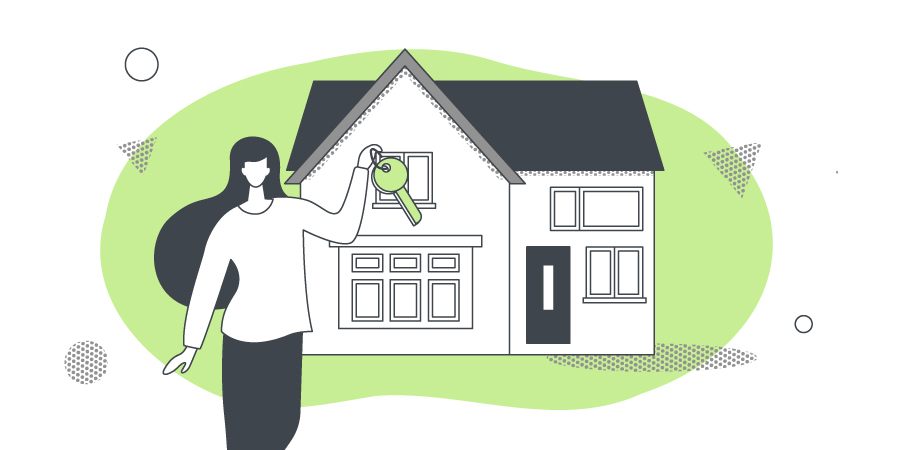
Key Takeaways
Here is an example of a short property chain:
Start of the chain: A first-time buyer. They’re not selling, only buying.
Next link: A Homeowner – selling their home to the first-time buyer and purchasing a new home from a retiree.
End of the chain: A retiree – selling their home to the previously mentioned homeowner. They’re then planning to move in with family.
This is referred to as a two-person chain as two home purchases need to take place.
Throughout this article, we’re going to address some of the key questions surrounding property chains, discuss what can go wrong, and explain some of the most frequently asked property chain questions. We’ll also explore the benefits of being ‘chain free’ and how buying brand-new with Barratt Homes could help.

Main reasons property chains can fail
Each transaction within a property chain has a knock-on effect on the rest of the chain. And that means things can be uncertain. If one transaction fails – due to someone pulling out of a purchase, or if someone finds it difficult to sell their property – the entire chain could collapse. According to ‘This is Money’, purchasing figures prove how much of an issue this is, with over 300,000 sales falling through each year due to a collapsed chain. Obviously, this can create a large amount of stress for everyone involved.
Here are a few of the key reasons a property chain might fail:
1. Can’t get a mortgage Mortgage applications can fail, especially as applicants are facing stricter lending criteria since the mortgage market review. If a buyer can’t get sufficient financing to buy a home, they’ll have to pull out of the transaction, which will break the property chain.
2. Issues with a property report
A property survey is not a legal requirement, and many sales will go ahead without a survey or report being conducted. But if a property survey is done and it uncovers significant problems, this can result in a failed sale – particularly when the seller is unwilling or unable to reduce the sale price to cover the estimated costs of repair.3. Gazumping
This means that the seller accepted a higher offer from another buyer. And studies have shown that 19% of house sales fail due to ‘gazumping’. Although this seems unfair, this is a legal process in both England and Wales . Interestingly, gazumping is much less common in Scotland due to the way in which property transactions are conducted.4. Change of mind
Most failed property chains occur because a party involved simply changes their mind. The seller might decide to take their home off the market. Or the buyer might find another home that they prefer to buy, or they may simply decide they don’t like the home enough to buy it.5. Change in personal circumstances
Some sales and purchases can fail due to personal circumstances like illness or change in relationship. For example, if a couple wanted to buy a house together and then decide to separate, they may need to pull out of the transaction as the mortgage they may have applied for would have been based on a combined income. As such, they’d need to get a new mortgage quote, and the property may not be affordable on a single salary.When the chain breaks, people can miss out on their dream property, incur a range of different fees, and fail to sell their current property at the price they were aiming for. And sadly, the various valuation, survey, conveyancing, and brokerage fees aren’t refundable. Those within a failed chain are often the ones to incur the financial burden – and losses can be substantial.

Property Chains – you’ve got questions, we’ve got answers
1. What do ‘chain free property’ and ‘no chain’ mean?
Being chain free means you’re able to buy a home without waiting to sell your home, a seller to sell their home, and so on.
Even when individual buyers or sellers are chain free it’s still possible for a property transaction to be dependent on a chain. For no property chain to exist both buyer and seller must be chain free. For example.
- First-time buyers buying a new build.
- A cash buyer purchasing from a seller who doesn’t need a new property in order to sell their current one (maybe they are going to rent or live with family).
2. How long does it take to buy a home with no property chain?
Without a property chain, you don’t need to worry about other transactions completing at the same time. You just need to follow your own conveyancing journey, and this can take anywhere from 4 weeks to 3 months.
Interestingly, properties sold without a chain attached are in high demand – so you might find that your property sells faster. That’s due to the fact that buyers value the speed and increased certainty of purchasing a chainless property. So much so, that companies like Rightmove have recorded a 72% increase in the number of buyers including “no chain” in their search terms.
3. What Is the average length of a property chain?
This is like asking ‘how long is a piece of string?’, and it depends on a lot of things. However, research by Zoopla shows it can take around 130 days to sell a house when the property market is ‘hot’, and up to 200 days when it’s not.
But remember, the length of a property chain is not really a great indicator of how long things will take. You could have six properties involved, and a relatively problem-free chain that moves quickly. Alternatively, you could have a chain with two or three properties that runs up against countless delays and ultimately fails. Each property chain is unique.

Benefits of being a chain-free buyer
As discussed, property chains can be uncertain. If you’re a first-time buyer or a chain-free seller, you have an advantage in the property market, and can be desirable for those looking to buy or sell property. Here are a few of the key benefits:
- Chain-free sellers – also referred to as properties being sold without a chain attached – are in high demand due to the fact that the transaction will often be faster and there’s less risk of it all failing. This level of certainty is valued by buyers so much so that many include ‘no chain’ when searching for properties online.
- Chain-free buyers can negotiate harder, as your purchase is not dependent on the sale of a property you currently own which, again, adds a level of certainty to the transaction.
- More peace of mind, and a lot less stress. Being chain free means you can stress less as you’re only conducting one transaction and not waiting for multiple things to fall into place at the same time.
How to avoid property chains when buying a home
Here are two things to look out for when you’re buying if you want to avoid a property chain:
- Buy a new-build home: You don’t need to worry about an onward chain, as the home is already empty.
- Search for chain-free properties: Often, empty properties won’t have an onward chain, so buying a vacant property can streamline things.
What’s more, you can make yourself a chain-free buyer by selling your current home and renting while you search for a new home.

Buying a chain-free home with Barratt Homes
If you’re looking to avoid property chains and eliminate some of the home-buying stress, Barratt Homes can help.Buying a new-build home means things can move along easily, as you’re not waiting for the seller of your property to move – you’re moving into a brand-new home where everything is a blank canvas for you to make your stamp on, and it’s all covered by warranties. And due to the fact that you’re the first occupant, there’s no onward chain.
If you’re interested in a beautiful, energy-efficient and modern, new-build home, check out our Barratt Homes website.
How to avoid property chains when selling your home
If you’re eager to avoid a chain when selling your home, you can:
- Choose a chain-free buyer — for example, a cash buyer or a first-time buyer.
- Tell your estate agent that you will only accept offers from chain-free buyers.
- Speak with developers who can buy your home outright for cash.

We could help you be a chain-free seller
At Barratt Homes, we offer a range of schemes to help you skip the chain and sell your home quickly and easily.
Our Part Exchange scheme means that we could buy your existing home from you, so you can quickly and easily move into one of ours. That eliminates some of the pressure, and – you’ll be pleased to learn – some of the costs, as there will be no estate agent fees to pay. Depending on which home you choose, you could even move into your new property within a matter of weeks.
If that’s not for you, we have other amazing schemes on offer to make the entire process as easy and stress free as possible. Here are our other offers:
- Part Exchange Guarantee: We could buy your existing home from you, and if it sells for more than the agreed offer, you’ll receive any profit.
- Part Exchange Xtra: We could organise the sale of your existing home for you and if your home doesn’t sell, we could be your guaranteed buyer.
- Movemaker: We could help you arrange to sell your existing home, so you’ll have no estate agent fees to pay.
Find out more here.
Wherever you’re at in your home-owning journey, we hope you now feel more confident about what a property chain actually is. If you’re thinking about moving and trying to work out what’s best for you, there’s nothing like owning a brand-new, energy-efficient home designed for modern living.


